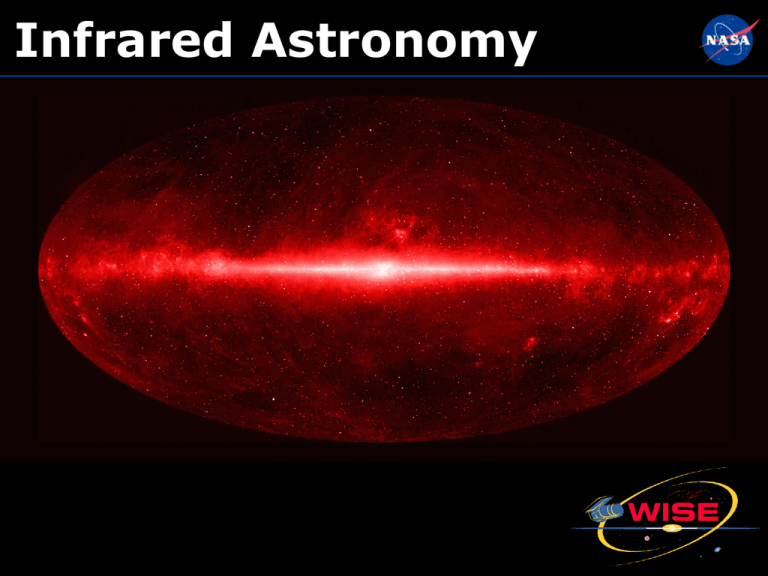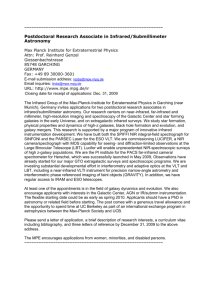infrared
advertisement

Infrared Astronomy Infrared Light • In 1800 William Herschel discovered “invisible light” • It’s energy with all the same characteristics as visible light, but is not sensed by the human eye • The light Herschel discovered was just beyond the red part of the spectrum. So it was named “infrared” The Spectrum of Light • Visible light is a tiny fraction of the Electromagnetic Spectrum • Gamma rays--billions of waves per inch • Radio waves--up to miles-long wavelengths Low Energy Waves High Energy Waves The Physics of Light • All objects in the Universe emit light depending on their temperature. • Cool objects emit primarily long wavelength light • Hot objects emit primarily short wavelength waves The Range of Infrared Light Infrared light lies just beyond the red portion of the visible spectrum ("below red“). Infrared wavelengths are about 0.7 to 350 microns. (a micron is one-millionth of one meter, or about 1/50th the width of a human hair). Near Infrared Mid Infrared The Range of Infrared Light SPECTRAL REGION WAVELENGTH RANGE (microns) TEMPERATURE RANGE (degrees Kelvin) WHAT WE SEE Cooler red stars Near-Infrared 0.7 – 5 740 – 5,200 Red giants Dust is transparent Planets, comets and asteroids Mid-Infrared 5 – 40 93 – 740 Dust warmed by starlight Protoplanetary disks Emission from cold dust Far-Infrared 40 – 350 11 – 93 Central regions of galaxies Very cold molecular clouds Getting the WHOLE picture An object can look radically different depending on the type of light collected from it: Since shortly after Herschel discovered infrared light astronomers have been observing astronomical objects in Infrared Light to get a more complete picture Visible Light Image Mid-Infrared Light Image Why Study Infrared? • Visible: dark nebula, heavily obscured by interstellar dust (“Horsehead Nebula”) • Near-Infrared: dust is nearly transparent, embedded stars can be observed forming • Mid- and Far-Infrared: glow from cool dust is directly observable Visible Near Infrared Mid-Infrared Why Study Infrared? • Cool objects--like newly forming stars and solar systems-emit almost exclusively in the Infrared Why Study Infrared? Infrared penetrates intervening dust clouds, allowing us to see through or into them Visible Light Infrared But there’s a Challenge... • Earth’s atmospheric water vapor absorbs almost all incoming infrared radiation • Even mountain-top observatories get a limited view of the infrared universe Infrared telescopes need to observe from high altitude or in space NASA’s Infrared Missions Spitzer Space Telescope SOFIA WISE James Webb Space Telescope Constellation Orion Visible Light Constellation Orion Mid Infrared Light IRAS Trifid Nebula Visible Light NOAO Trifid Nebula Infrared Light Spitzer Orion Nebula Visible Light Orion Nebula Infrared Light Spitzer Sombrero Galaxy Visible Light HST Sombrero Galaxy Infrared Light Spitzer The Whole Sky Visible Light - Axel Mellinger The Whole Sky Near Infrared Light - 2MASS Survey The Whole Sky Mid/Far Infrared Light - IRAS Survey





